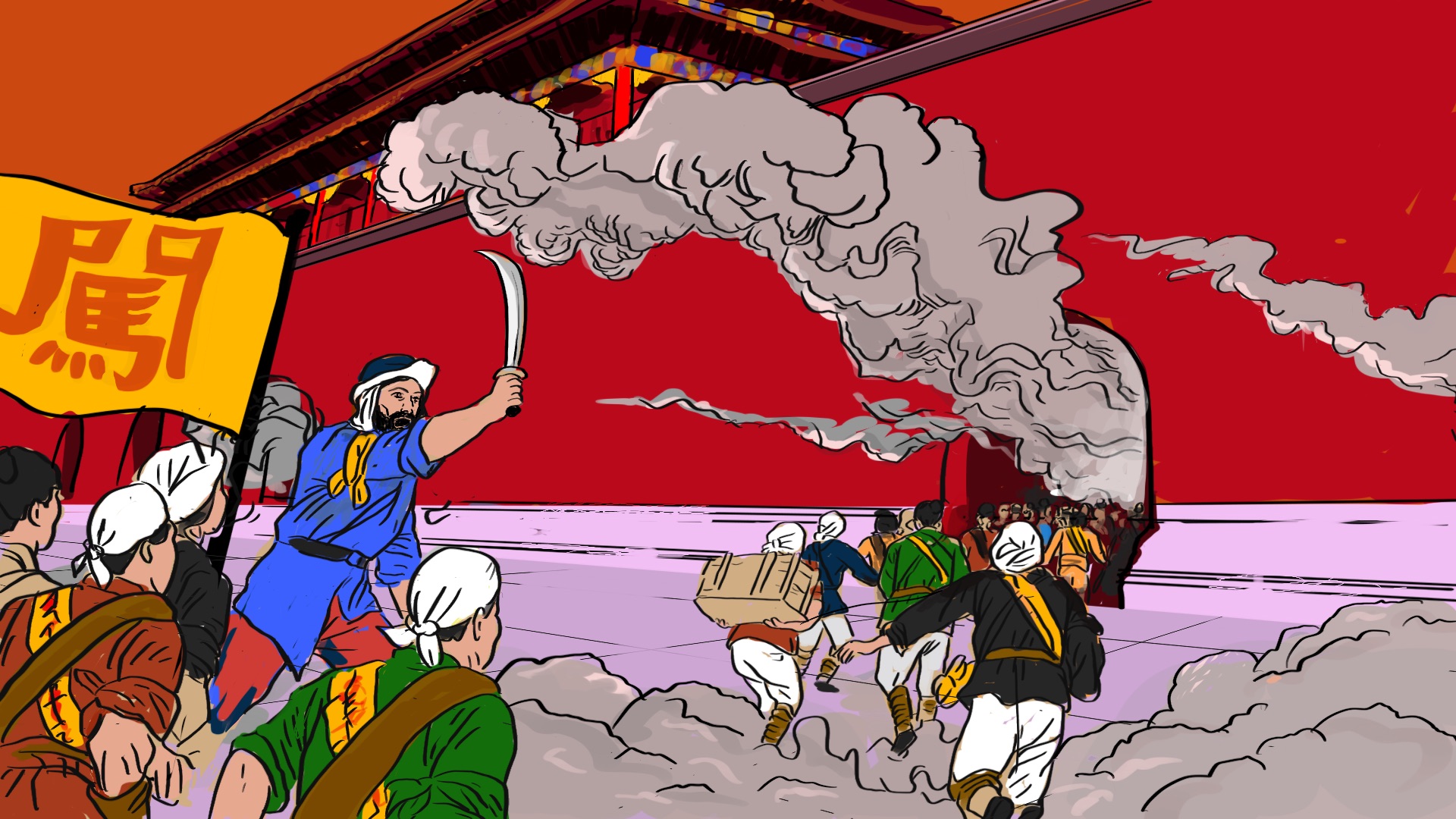Li Zicheng sets fire to the Forbidden City
Nearly 400 years ago, the Forbidden City burned.

This Week in China’s History: June 3, 1644
This column marks one year of writing this column, covering events as recent as January 2021 and as long ago as 750. The response has far exceeded anything I expected; thank you for taking the time to read.
One of the reasons we began this column last June was the weight of history surrounding June 4, 1989. A year ago, I focused on the commemorations of June 4 and how they are changing, especially in Hong Kong. Without diminishing those events, I’d like to focus this first week in June on another historical event with lasting impact, hoping that we still remember what happened in 1989.

It is early June, by the Western calendar. Smoke rises from the center of Beijing. Tiananmen, the Gate of Heavenly Peace, looks out over a scene of betrayal and massacre. Thousands are dead, some killed by troops acting on the order of leaders intent on maintaining, or regaining, power. Often, soldiers don’t know whose orders to follow, as rumors of treason and backroom deals spread. In some cases, Beijing residents, enraged by the violence that had overtaken their city, took revenge on an occupying army.
The description fits 1989, but it is 355 years earlier: 1644. And while June 1989 was a watershed in China’s history, June 1644 cast an even longer shadow, leading to the foundation of one of China’s longest, most influential — and final — imperial dynasties: the Qing.
The big picture of the Ming-Qing transition is one of transformation, with enormous consequences when viewed from any number of perspectives. But the details of June 1644 are fascinating by themselves, so that is what we’ll focus on here. The essential source for these details in English remains Frederic Wakeman’s 1985 classic, The Great Enterprise. Its two volumes and 1,300 pages made generations of graduate students wonder if the title referred to the Manchu conquest or reading the book, but Wakeman’s lively narrative and thorough synthesis make it well worth the investment.
Like any important event, it is difficult to pinpoint starting and ending points, but with our focus on the first days of June, let’s go back just a little further, to May 25. In the hills near the Bohai Gulf just north of the Great Wall, two armies were preparing to do battle. The first of these was composed of Ming troops led by General Wú Sānguì 吳三桂 (spoiler alert: we talked about his role last fall). Wu’s orders were defending his emperor against the second army: Manchus led by Dorgon, the prince regent of the Qing dynasty, which had been encroaching on the weakening Ming for decades. And while the better equipped and trained Ming and Qing armies faced off, a third army — Lǐ Zìchéng’s 李自成 recently proclaimed Shun dynasty — was approaching too.
With designs on conquest, Dorgon’s Manchu Grand Army had left its capital — today’s Shenyang — and marched toward China, its passage blocked by Wu’s forces. Dorgon had started his march thinking that he might ally with the rebels against the Ming. There was even discussion of a possible power-sharing arrangement that might divide north China between the Shun and the Qing.
But circumstances were changing quickly. On May 20, Dorgon had learned that the Ming emperor was dead and Li Zicheng had occupied the capital. No longer was Li Zicheng’s force a potential ally; now they both had an opponent and an opportunity. The military challenge of overthrowing the Ming was no small feat, but winning over China politically would be even harder. Dorgon’s Chinese advisor suggested that presenting the Manchu invasion as avenging the Ming rather than conquering it might be the way to win hearts and minds.
Might a foreign invasion be preferable to domestic insurgents? Stories out of Beijing suggested it might. Wakeman cites Fàn Wénchéng 范文程, a Han Chinese statesman who served several early Qing emperors as an advisor, who describes how Li’s army had abused the people of the capital. Rape, looting, and arson were common, and such outrages were proof that the Mandate of Heaven, though it had slipped from the Ming’s grasp, did not belong to the outlaws led by Li Zicheng.
Wu Sangui, the Ming general, was recalculating his options. His emperor had hanged himself, and although he had been tasked with defending the Great Wall pass at Shanhaiguan against the invaders from the northeast, the well-ordered, disciplined, and superior-armed Manchu forces seemed in many ways a better option than the peasant rebels that now occupied Beijing. He had written a letter to Dorgon proposing an alliance to help restore the Ming, in exchange for territories already occupied and “great profits.” Dorgon, sensing the balance of power, accepted the idea of an alliance, but there would be no restoration. He welcomed Wu Sangui’s help to avenge the Ming by establishing the Manchu Qing in its place as heirs to the Mandate of Heaven.
Wu decided to take the offer. At dawn on May 27, Wu Sangui personally surrendered to Dorgon and cast his lot with the Manchus.
Li Zicheng soon found himself facing a combined Ming-Qing invasion. To their surprise, the rebel army that many had expected to be undisciplined and poorly equipped fought Wu’s army to a standstill, until a sandstorm and flanking Manchu troops turned the tide of battle. The Manchu cavalry seems to have caught the Shun army by surprise, and stalemate turned to defeat. Defeat then turned into chaos. Li Zicheng, who had personally led his troops into battle, attempted to reorganize for another attack, but the line was broken. Shun soldiers streamed back to Beijing, some venting their frustration and rage by putting the neighborhoods near the city wall to the torch.
Li Zicheng himself and most of his army returned to the capital on May 31. Admitting defeat rather than plotting a next move, they began pillaging the city that for a month had been their capital.
For a reign that had been brief and inglorious, Li Zicheng saved two grand gestures for its end. On June 3, he arranged “a formal but hasty coronation ceremony,” in Wakeman’s words, thrusting himself into the annals of history as the Yongchang Emperor of the Shun Dynasty. Then on June 4 — the first and only day that dawned with him as emperor in Beijing — Li Zicheng ordered the palace, along with most of the city, burned.
History doesn’t repeat itself, but some coincidences are hard to ignore. One is Frederic Wakeman’s description of a long ago June 4, published some five years before that date would become shorthand for one of modern China’s darkest chapters: “‘Smoke and flames filled the sky,’ and fires burned in almost every district of the city…All in all, nearly two thousand were slaughtered before the killing stopped. The traumatized city slowly settled into quiet, tensely awaiting its new occupier.”
This Week in China’s History is a weekly column.





